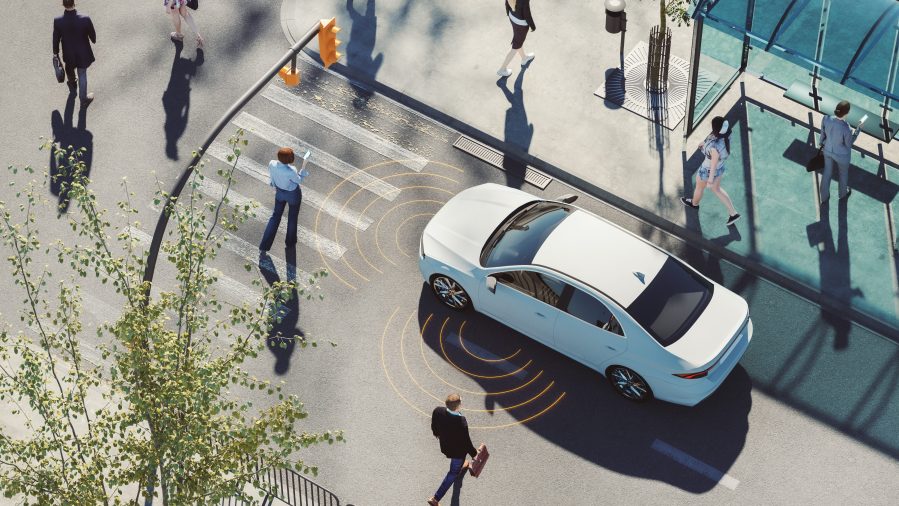Safe and sound: how EVs tell you they’re coming

There’s a federal regulation requiring “quiet vehicles” — meaning hybrid and electric cars — to emit synthetic sounds. That’s because without noisy combustion engines, EVs produce no sound of their own at speeds under about 18 mph, which would make them dangerous to other road users, particularly visually impaired pedestrians. So those sounds are added on.
We wanted to know why these cars sound the way they do, so we asked Danielle Venne. She’s the executive creative director at Made Music Studio, a sonic branding agency in New York City. Venne describes her work in sonic branding as “the strategic use of sound and music to help brands build their own identity.”

In 2017, Nissan approached Venne and her team and asked them to design a sound for the company’s fleet of electric vehicles that would hit the market in the coming years. The sound would be played externally, heard by pedestrians, cyclists and other roadway users when the vehicle approaches.
“We love that these electric cars are quiet,” Venne said. “There’s no noise pollution with them, or minimal noise pollution, but it’s still a safety hazard.”
Because hybrid and electric cars are now required to have synthetic noises built in, Venne said, there’s “an opportunity and a need to look at that sound through the lens of the brand and through the lens of marketing.”
The deliverable that Venne and her team were asked to compose for Nissan was a two-second piece of audio that would be looped on hardware within the company’s Leaf vehicles.
“When the car is idling, you’re just going to hear that one piece of audio looped,” Venne said. “It should sound smooth; it shouldn’t sound like it’s hiccupping every two seconds. It should be a perfect loop.”
In addition to being a smooth loop, the sound would need to change with the speed of the car. As the speed increases, “the note that you’re hearing is going to increase in pitch and speed by 1% per kilometer per hour, up to 30 kilometers per hour,” Venne said.
Venne said the product for Nissan was different from others she’s worked on.
“It’s not a melody, it’s not a piece of music. It’s not even a singular sound,” Venne said. “Instead, that deliverable is a looped piece of audio that has to stretch like an accordion or like taffy and then come back together.”
To find the perfect sound, designers at Made Music Studio created three categories to explore. Those categories included smooth sounds, wavelike sounds and sounds built on motion.
“Very early on, you start to realize that if you’re trying to convey that this car is innovative and that this car is different than a gas-engine car, having too many moving sounds really doesn’t depict that this is new technology,” Venne said. “It sound likes a weirder version of an internal combustion engine.”
Venne said working on the sound design for the Nissan Leaf changed how she hears cars driving around New York.
“I have such a different appreciation for all the design considerations that went into that vehicle, including the sound I’m hearing as it comes towards me.”
Related links: More insight from Meghan McCarty Carino
After the U.S. Department of Transportation finalized its “quiet car” rule in 2018, there was some hope among EV owners that the new regulation would bring with it the option to fully customize the sound of an individual car. For a few years, it seemed like drivers would someday be able to select from a catalog of sound effects to signal when their car is backing up or slowly pulling forward.
But last summer, safety regulators scrapped that plan, saying there was a lack of data illustrating exactly why that level of customization would be necessary.
It’s an especially disappointing decision for some Tesla drivers who were excited to have the option of blasting fart sounds at unsuspecting pedestrians. That functionality was available in some Tesla models, which have since been recalled.
Probably good news for the rest of us.
Though it seems the fart feature does still work when the car is not moving.
The future of this podcast starts with you.
Every day, the “Marketplace Tech” team demystifies the digital economy with stories that explore more than just Big Tech. We’re committed to covering topics that matter to you and the world around us, diving deep into how technology intersects with climate change, inequity, and disinformation.
As part of a nonprofit newsroom, we’re counting on listeners like you to keep this public service paywall-free and available to all.
Support “Marketplace Tech” in any amount today and become a partner in our mission.


















